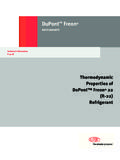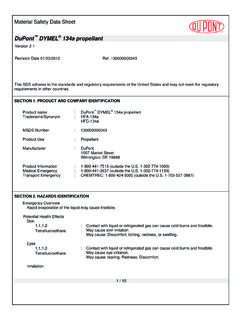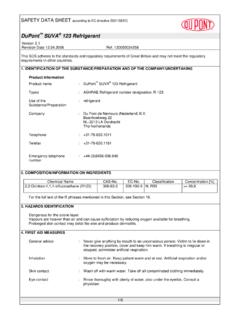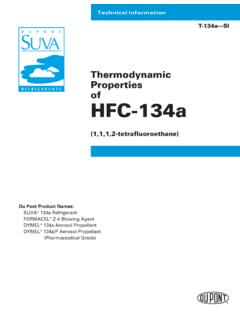Transcription of AS-1 Safety of DuPont™ Suva Refrigerants - Dansuk
1 Technical InformationAS-1 Safety of dupont suva RefrigerantsDuPont Answers Your Questions about theSafe Handling and Use of dupont suva RefrigerantsSuva 409A (R-409A) is a ternary blend of HCFC-22, HCFC-124, and HCFC-142b that has beendeveloped as a replacement for CFC-12 in station-ary positive displacement air-conditioning andrefrigeration HP62 (R-404A) refrigerant is a ternaryblend of HFC-125, HFC-143a, and HFC- 134a thathas been developed as a long-term replacement forR-502 and some R-22 refrigeration applications inhigh-, medium-, and low-temperature HP62 can also be used to retrofit existing R-502 507 (R-507) is a binary blend of HFC-125and HFC-143a that has been developed as a long-term replacement for R-502 in commercial refrig-eration equipment.
2 It can be used in new or existingR-502 HP service Refrigerants are ternary blends ofHFC-125, HC-290, and HCFC-22 that have beendeveloped as replacements for R-502 primarily forretrofitting existing systems. suva HP80 (R-402A) is a primary servicerefrigerant replacement for R-502 in medium-and low-temperature refrigeration; it has dis-charge temperatures equivalent to R-502. suva HP81 (R-402B) is the preferred replace-ment for R-502 in limited applications where a10 to 20 F increase in compressor dischargetemperature is desirable, such as some icemachines and other self-contained suva RefrigerantsDuPont suva Refrigerants , which are composedof hydrochlorofluorocarbon (HCFC) andhydrofluorocarbon (HFC) compounds, weredeveloped as safe, effective alternatives to existingchlorofluorocarbon (CFC) 123 (R-123) is the dupont brand name forHCFC-123 refrigerant , which is a replacement forCFC-11 in centrifugal 124 (R-124) is the dupont brand name forHCFC-124 refrigerant , which will have applicationin some CFC-114 systems and is also a componentof suva MP 125 (R-125)
3 Is the dupont brand name forHFC-125, which is a component of some suva 134a (R- 134a ) and suva 134a Auto areDuPont brand names for HFC- 134a refrigerant ,which is a primary replacement for MP service Refrigerants are ternary blendsof HCFC-22, HFC-152a, and HCFC-124 that havebeen developed as replacements for CFC-12 andR-500 in a variety of applications. suva MP39 (R-401A) is a replacement forCFC-12 in medium-temperature stationarypositive displacement air-conditioning andrefrigeration systems. suva MP66 (R-401B) is a replacement forCFC-12 in low-temperature stationary refrig-eration applications and in some transport refrig-eration equipment. suva MP66 is also therecommended alternative for existing dupont Oval Logo, dupont , The miracles of science , andSuva are trademarks or registered trademarks of E.
4 I. du Pont deNemours and 408A (R-408A) is a ternary blend of HFC-125, HFC-143a, and HCFC-22. It has been devel-oped as a replacement for R-502 in existing low-and medium-temperature commercial refrigerationequipment. It is an option to suva HP80 wherelower operating pressures are desired; however, itdoes have higher compressor discharge 407C (9000) is a ternary blend of HFC-32,HFC-125, and HFC- 134a . It has been formulated asa similar pressure replacement for HCFC-22 in newor existing air-conditioning equipment and 410A (9100) is a binary blend of HFC-32and HFC-125. It is a high-pressure replacement forHCFC-22 for new air-conditioning 95 (R-508B) is an azeotropic mixtureof HFC-23 and PFC-116, designed as a replace-ment for R-503, CFC-13, and HFC-23 in verylow-temperature applications (below 40 F [-40 C]evaporator temperature).
5 Table 1 provides a quick summary of these refrig-erants, including composition, boiling point, andacceptable exposure limit (AEL) technical bulletin answers common safetyquestions, discusses potential symptoms of overex-posure, and provides first aid and medical advicefor effects of overexposure that may occur fromimproper use or handling of suva must read and understand the MaterialSafety Data Sheets (MSDSs) before handling orusing suva Refrigerants . Failure to follow theMSDS instructions could result in injury ordeath. An MSDS can be obtained for any DuPontrefrigerant from the dupont locations listed on thelast page of this technical bulletin, or from anyDuPont Refrigerants Authorized many years, CFCs have been used successfullyas Refrigerants , blowing agents, cleaning solvents,and aerosol propellants.
6 CFCs seemed an idealchoice due to their unique combination of proper-ties; however, the exceptional stability of thesecompounds, coupled with their chlorine content,has linked them to the depletion of the earth sprotective ozone a result, dupont and many other companieshave developed alternative Refrigerants to replaceCFCs. The dupont series of products are based onHCFC and HFC compounds. Unlike CFCs, HFCscontain no chlorine and, therefore, have zero ozone-depletion potential (ODP). HCFCs do containchlorine, but have up to 98% less ODP than presence of one or more hydrogen atoms inHCFC molecules allows them to break apart fasterin the lower atmosphere so that less chlorinereaches the ozone 1 Physical Properties of dupont suva RefrigerantsAverageOccupationalBoiling PointExposure Limit*ProductComposition, wt% C ( F) at 1 atm(ppm v/v) suva 123100% (82)50 suva 124100% HCFC-124 ( )1,000 suva 125100% HFC-125 ( )1,000 suva 134a100% HFC- 134a 26 ( 15)1,000 suva MP3953% HCFC-22/13% HFC-152a/34% HCFC-124 ( 33)1,000 suva MP6661% HCFC-22/11% HFC-152a/28% HCFC-124 ( )1,000 suva 409A60% HCFC-22/25% HCFC-124/15% HCFC-142b 34 ( 30)1,000 suva HP6244% HFC-125/52% HFC-143/4% HFC- 134a ( )
7 1,000 suva 50750% HFC-125/50% HFC-143a ( )1,000 suva HP8060% HFC-125/2% HC-290/38% HCFC-22 ( )1,000 suva HP8138% HFC-125/2% HC-290/60% HCFC-22 ( )1,000 suva 408A7% HFC-125/46% HFC-143a/47% HCFC-22 44 ( )1,000 suva 407C (9000)23% HFC-32/25% HFC-125/52% HFC- 134a ( )1,000 suva 410A (9100)50% HFC-32/50% HFC-125 ( )1,000 suva 9546% HFC-23/54% FC-116 88 ( )1,000*The occupational exposure limits listed are either the dupont Acceptable Exposure Limit (AEL) or Threshold Limit Value(TLV) established by the American Conference of Governmental Industrial Hygienists (ACGIH).3 Refrigerants should not be exposed to open flamesor electrical heating elements. High temperaturesand flames can cause the Refrigerants to decompose,releasing toxic and irritating fumes.
8 In addition,a torch flame can become dramatically larger orchange color if used in high concentrations of manyrefrigerants including R-500 or R-22, as well asmany alternative Refrigerants . This flame enhance-ment can cause surprise or even injury. Alwaysrecover Refrigerants , evacuate equipment, andventilate work areas properly before using anyopen causes decomposition? Refrigerants will decompose when exposed to hightemperatures from flames or electric resistanceheaters. Decomposition may produce toxic andirritating compounds, such as hydrogen chlorideand hydrogen can I tell if a refrigerant hasdecomposed?The strong odors released from the decomposedrefrigerant will irritate your nose and throat. Theirritating nature of these fumes released fromdecomposition will usually force you to evacuatethe area.
9 Follow all dupont recommendations forrefrigerant handling to prevent refrigerant decom-position and other decomposition productshazardous?Yes. The acidic vapors produced are dangerousand the area should be evacuated immediately andventilated to prevent exposure to personnel. Any-one exposed to the decomposition products shouldbe taken to fresh air and given medical treatmentimmediately. Do not attempt to continue workingin these fumes, they can injure ToxicityAre suva Refrigerants toxic? suva Refrigerants pose no acute or chronic hazardwhen they are handled in accordance with DuPontrecommendations and when exposures are main-tained at or below recommended exposure limits,such as the dupont Acceptable Exposure Limit(AEL).These alternative Refrigerants have similar perfor-mance characteristics to CFCs, but with greatlyreduced environmental impact.
10 suva refrigerantsare nonflammable and offer in-use stability andzero or reduced ozone-depletion and global-warming potential. Although they are not drop-inreplacements, HCFC- and HFC-based refrigerantsrequire minimal changes to existing equipmentwhen compared with other alternative products. Fordetailed discussions about retrofitting equipmentwith dupont suva Refrigerants , refer to DuPonttechnical bulletins ART-33, ART-34, ART-36, suva Refrigerants flammable? suva Refrigerants are nonflammable in air attemperatures up to 100 C (212 F) at atmosphericpressure, and under normal use conditions. How-ever, dupont suva Refrigerants should not bemixed with any flammable gases or liquids for anyreason because these mixtures can have unpredict-able flammability properties and could be of some suva Refrigerants with highconcentrations of air at elevated pressure and/ortemperature can become combustible in the pres-ence of an ignition source.









